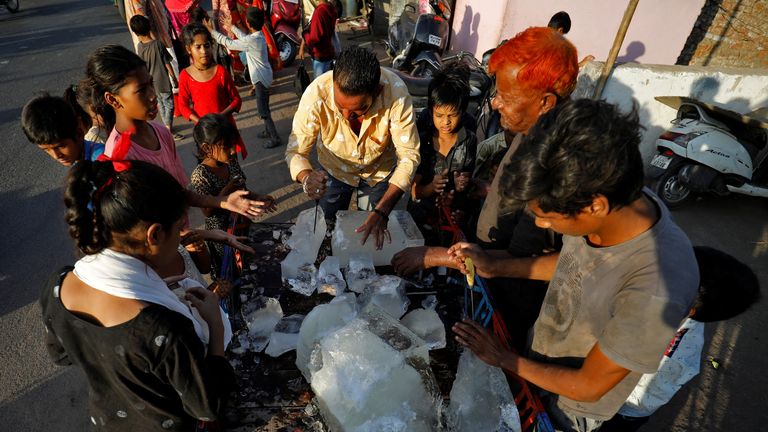[ad_1]
India and neighbouring Pakistan have been suffering from extreme heatwaves this year, melting pavements, forcing school closures and triggering fire alerts.
With high temperatures expected to continue in May, extreme heat swept across large areas of both countries last week and follows the hottest March since the India Meteorological Department (IMD) began keeping records 122 years ago.
In April, northwest and central India recorded average maximum temperatures of 35.9C (96.6F) and 37.78C (100F), the director general of the Indian Meteorological Department said.
In the Indian capital New Delhi, temperatures soared past 40C (104F) for several days.
Pakistan issued a heat warning after the hottest March in 61 years.
For the first time in decades the country went from winter to summer without the spring season, Pakistan’s Federal Minister for Climate Change, Sherry Rehman, said at the weekend.
“South Asia, particularly India and Pakistan are faced with what has been a record-breaking heatwave. It started in early April and continues to leave the people gasping in whatever shade they find,” she said in a statement.
India’s Prime Minister Narendra Modi has also warned of the impact of hot temperatures and the growing risk of fires.
The country’s electricity demand hit a record high in April, with a surge in the use of air conditioning from hot temperatures triggering the worst power crisis in more than six years.
Electricity use is expected to grow as India’s weather office has forecast above normal maximum temperatures over most parts of the west central, northwest, north and northeast of the country.
The power demands have forced India to row back on a policy to cut down on coal imports. Burning coal generates around 60-70% of its electricity.
The world’s second largest coal consumer had expected to phase down the dirtiest fossil fuel after it committed at the COP26 climate conference to reach net zero emissions by 2070.
But the federal government has asked state and private sector utilities to ensure delivery of 19 million tonnes of coal from overseas by end of June, Reuters has reported, in an urgent push to stave off further power blackouts.
Climate change contributions
Scientists have warned that more than a billion people are at risk of heat-related impacts in the region and have linked the early onset of an intense summer to climate change.
In February, a report by the Intergovernmental Panel on Climate Change warned of India’s vulnerabilities to extreme heat.
At 1.5C of warming above pre-industrial temperatures, the West Bengal capital of Kolkata could once a year see conditions match that of the 2015 heatwave, when temperatures hit 44C (111.2F) and thousands died across the country, it said.
With summer temperatures in April and May, cooling monsoon rains are expected to arrive in June.
Real danger from high temperatures and high humidity
While heat risks lives and livelihoods in India, additional danger is posed when high temperatures mix with high humidity, making it difficult for people to cool down through sweating.
Such conditions are measured by “wet bulb temperatures” which record the reading of a thermometer wrapped in a wet cloth.
High wet bulb temperatures are of particular concern in India, where most of the country’s 1.4 billion people live in rural areas without access to air conditioners or cooling stations.
Flash floods from melting glaciers
Pakistan’s Federal Minister for Climate Change also said the government has told provincial disaster management authorities to prepare urgently for the risk of flash flooding in northern mountainous provinces due to rapid glacial melting.
Glaciers in the Himalaya and other mountain ranges have melted rapidly, creating thousand of glacial lakes in northern Pakistan, around 30 of which are at risk of sudden hazardous flooding, the climate change ministry said.
[ad_2]








